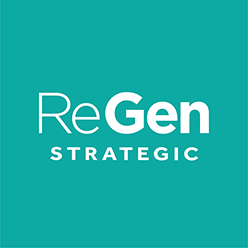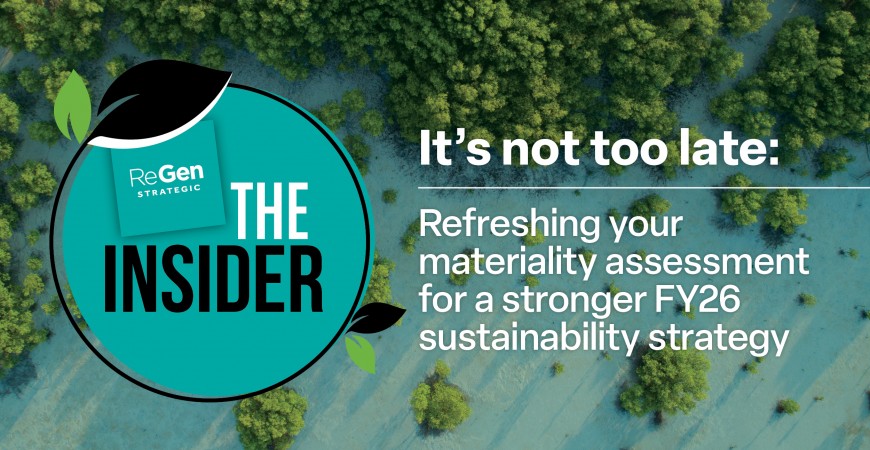With FY25 now behind us, many organisations are reflecting on financial performance, operational delivery, and strategic direction. But for businesses committed to sustainability, this time of year also presents a critical opportunity to reassess how well their strategies align with current risks, stakeholder expectations, and evolving regulatory landscapes.
Ideally, the months leading up to the end of the financial year are when companies review their sustainability strategy and conduct or refresh their materiality assessment. Doing so ahead of year-end ensures that updated sustainability priorities are embedded in budgeting, planning, and reporting for the new financial year. However, if that window has passed, the early part of FY26 remains a strategically valuable time to act. It’s not too late. In fact, now may be the best moment to engage in a recalibration while your organisation is already in planning mode.
At ReGen, we work with a diverse range of clients, all with differing levels of sustainability maturity. We assist them in strengthening their sustainability performance through clarity, structure, and technical insight. A central component of this work is helping organisations conduct robust materiality assessments that reflect both financial and sustainability impacts. We do this by applying a double materiality lens, which has become the global best practice standard.
What is double materiality?
Double materiality considers not only how environmental, social and governance factors impact an organisation’s financial performance (outside-in), but also how the organisation itself impacts the environment and society (inside-out). This approach provides a more complete view of an organisation’s material risks and opportunities. It is increasingly expected by stakeholders and embedded in key frameworks such as the EU’s Corporate Sustainability Reporting Directive (CSRD) and the International Sustainability Standards Board (ISSB) baseline standards.
Why does a materiality assessment need to be refreshed?
Many people mistakenly presume a materiality assessment is a one-off exercise; it isn’t. The external landscape continues to shift, often quickly and with broad implications for business. Stakeholder concerns, regulatory requirements, market risks, and societal expectations do not stay static. What was considered material a year ago may now be less relevant, or in need of urgent re-evaluation. We are seeing this clearly in areas such as climate-related financial disclosures, biodiversity impact and community expectations.
For many organisations, especially those operating where the environment is complex and scrutiny is high, ensuring that sustainability priorities are current and grounded in stakeholder input is critical. That’s where robust materiality assessments come in. They provide a clear, evidence-based way to prioritise sustainability topics and determine where to focus attention, resources, and reporting efforts.
What are the benefits of a mid-year review?
Undertaking a materiality refresh early in FY26 has several benefits. First, it allows your sustainability strategy to align with the most recent expectations of regulators, investors, and the communities in which you operate. Second, it sets a foundation for effective engagement across the business, building internal understanding of how sustainability links to core business value. Third, it ensures your next sustainability report reflects what truly matters today, not what was relevant 18 months ago.
We recently supported a client in the mining sector with a mid-year materiality assessment review. Their original strategy, developed a couple of years prior, had focused heavily on emissions and workforce safety. While still important, our updated materiality assessment revealed a marked shift in stakeholder sentiment toward other material topics. The insights shaped a new strategic direction, enhanced local engagement efforts, and positioned the company to report more meaningfully on the topics that matter most to its stakeholders.
More broadly, companies that keep their sustainability strategies up to date through regular materiality assessments tend to have stronger governance, better risk management, and more coherent sustainability narratives.
Although the pre-EOFY period is optimal for this kind of strategic work, the opening quarter of the financial year still provides an excellent window. There is time to consult with stakeholders, test assumptions, and realign your priorities. Importantly, any insights gained can be applied immediately to shape FY26 implementation plans and resourcing decisions.
At ReGen, we always inform our clients that sustainability strategies should never be static. A meaningful, future-focused sustainability strategy begins with a deep understanding of material topics viewed through the dual lenses of financial and sustainability risks and opportunities. If your organisation hasn’t reviewed its material topics and/or its sustainability strategy in the last 12 months, now is the time.
 ReGen Strategic
ReGen Strategic